
While medical advice says to avoid alcohol, medical science says it could actually be good for you
A businessman goes to his GP. ‘My hands hurt, I get a bit of a pain in my chest sometimes, and I’m beginning to forget things,’ he complains.
The doctor examines him and says: ‘You’ve got a touch of arthritis, possibly mild heart disease, and you may be in the first stages of dementia. How much are you drinking?’
‘Never touch a drop, doctor,’ says the patient proudly.
‘Ah, that explains it,’ says the GP, wagging an admonishing finger. ‘Here’s a prescription for red wine — a quarter of a litre a day.’
Ridiculous? Absurd? A story from the Bumper Book of Jokes for Alcoholics? Absolutely not.
Let me tell you this: if GPs fail to recommend alcohol to at least some of their patients, they should be had up for medical negligence.
That, at least, is the logical conclusion I’ve drawn from an in-depth study of around half-a-million scientific papers about alcohol.
To my surprise, they contained findings that would make any pharmaceutical company uncork the champagne. Except they never will, of course, because alcohol can’t be patented as a drug.
Most of the evidence suggests that if red wine, in particular — and to a lesser degree white wine, beer, lager and spirits — were used as a preventive and therapeutic medicine, disease rates would fall substantially. Not only that, but lives would be saved — with huge benefits to the economy.
In fact, red wine may well be one of the most effective ‘medications’ in history.
Like other drugs, it has side-effects. It has a minimum and maximum therapeutic dose — take too little and it won’t work; take too much and it may make you ill.
And it has a daily treatment regime: ideally, you should take wine once a day with the evening meal.
Yes, daily. I know that the medical profession urges us to stop drinking at least two or three days a week, but this isn’t borne out by scientific studies. These consistently show that daily moderate drinking is the best for health.
OK, but what is a moderate amount? Unfortunately, that’s where it gets a bit more complicated, because the prevention and treatment of different diseases seem to require differing amounts — varying from a small to a large glass a day, but sometimes more.
Of course, most people already know red wine is supposed to be good for your heart. But, that aside, the endlessly repeated public message is that alcohol is Bad News.
Now, I’d be foolish to deny that over-indulging in booze can be harmful to society. You need only think of alcohol-fuelled crime, road deaths, city centre mayhem, domestic violence, and costs to the NHS.
But to show only one side of the picture, as government and medical authorities inevitably do, is simply bad medicine. It prevents people making sensible decisions about their own health.
Why haven’t doctors ever come clean about all this? The reason is fairly obvious: they don’t trust us.
One shining exception is Professor Karol Sikora, the UK-based consultant oncologist who’s written the foreword to my new book about the benefits of alcohol.

Red wine seems to be the most beneficial, but as with any medicine taking too much can be harmful
Too much booze, he warns, not only kills but ‘ruins lives, destroys families, ends successful careers, causes untold physical and mental illness and has a huge adverse impact on society’.
However, he continues: ‘If you don’t drink at all, you have a defined risk of developing all sorts of medical problems in your heart, joints, brain, blood sugar levels, and kidneys — indeed all round your body.
‘As you begin to drink, there seems to be evidence of benefit. As you drink more, that gradually disappears and the damaging effects kick in.’
But let’s be clear here: I’m not recommending anything personally. I’m just an averagely intelligent science journalist who’s done what anyone else can if they have the time: I’ve looked at the scientific and medical data published in top-flight journals, and collated the evidence.
So, readers should consult knowledgeable health professionals before acting upon anything they read below. The trouble is, most doctors know very little about this area, because they, like you, have been largely kept in the dark.
Here, though, is some of the evidence I found — and it’s more than a little surprising.
Heart Disease
From the Nineties, experts at Harvard University monitored 12,000 men with high blood pressure for nearly 13 years.
All the men were doctors, and some were drinking far more than the accepted alcohol limits. In the UK, these are 16 grams a day for women — the alcohol in just over a medium glass of wine — and 32 grams for men, roughly half a bottle of red wine.
Working in grams per day is far easier than the hopelessly confusing system of units.
So what happened in the Harvard study? The more these men drank, the less chance they had of a heart attack.
Drinking 10 to 15 grams (up to a medium glass of wine) a day reduced risk by nearly 40 per cent. But at over 50 grams (two-thirds of a bottle of wine), the risk went down even further — by nearly 60 per cent.
Similar results were found in a 13-year Oxford University study of British doctors, some of whom also drank over the guidelines.
‘The consumption of alcohol appeared to reduce the risk of ischaemic heart disease, largely irrespective of amount,’ the Oxford researchers reported.
In fact, the evidence from over half a century’s research seems to be overwhelming: alcohol is associated with a reduced risk of all forms of heart disease.
And alcohol can also help people with existing heart disease; in other words, it acts just like a pharmaceutical medication.
A huge nine-year study of nearly half a million Americans revealed that alcohol ‘significantly’ prolonged the lives of people already suffering from heart disease — and this applied even to people who drank more than 56 grams of alcohol (two-thirds of a bottle of wine) a day.
Common Cold
Drug companies have spent billions trying to find a way of preventing colds, and failed.
However, the answer has been staring us in the face all along, because astonishingly, both wine and alcohol in general help prevent the common cold — and very effectively, according to a joint research venture between Harvard and Spanish universities in 2002.
The results were astounding: up to a 60 per cent reduction in the risk of catching a cold among red wine drinkers, and a staggering 88 per cent reduction in white wine drinkers.

This finding was reinforced by an earlier placebo-controlled clinical trial in Britain’s Common Cold Unit in 1993, when 400 regular drinkers and a smattering of teetotallers were deliberately infected with a cold virus.
Remarkably, it was the teetotallers who were most susceptible to getting a cold. And the effect of alcohol was huge: people who drank 20 grams (just over one large glass of wine) of alcohol a day had almost ten times fewer cold symptoms than teetotallers.
No drug, herb or medical intervention can come close to offering that level of protection.
Breast Cancer
In 2008, a study was done on about 1,500 women in Southern France who’d developed breast cancer in the previous two years.
Their lifestyles were then analysed in detail, including the types of alcohol they drank, how much and how often. A matched ‘control group’ of healthy women was also surveyed.
The findings were dramatic. First, none of the breast cancer cases appeared to have any association with alcohol intake — no matter how much the women usually drank.
Second, drinking up to 15 grams of alcohol a day of wine (a medium glass) actually reduced the risk of breast cancer — by a remarkable 42 per cent.
Third, the greatest protection occurred among the women who drank wine every day; there was no benefit whatever if they drank sporadically.
So the researchers had no option but to conclude: ‘Low and regular consumption of wine reduces the risk of breast cancer.’
Two years later, those French findings were bolstered by a University of Ottawa study on women at risk of one particular breast cancer type — the BRCA1 genetic mutation.
‘Compared with non-drinkers,’ it said, ‘exclusive consumption of wine was associated with a significant reduction in the risk of breast cancer.’
In 2012, the Cedars-Sinai Medical Centre in Los Angeles reported that red wine specifically has beneficial effects on some of the hormones implicated in breast cancer.
Meanwhile, at least two studies on mice have shown that the natural ingredients of red wine can reduce breast cancer tumours.
However, we should be cautious. Although four population studies have found that wine doesn’t cause breast cancer, about four disagree. And Cancer Research UK is adamant that drinking alcohol has been shown to increase the risk.
Certainly, the evidence is fairly clear that alcohol in general isn’t good news for breast cancer, with roughly a 10 per cent increase in risk for every tot of spirits or half pint of beer you drink.
Diabetes
In 2009, researchers at Canada’s Centre for Addiction and Mental Health analysed more than 1,500 studies on the link between alcohol and diabetes.
They concluded that drinkers have a 13 per cent lower risk of contracting it than teetotallers.
An earlier Dutch analysis looked at data on nearly 370,000 people whose health had been tracked for 12 years. If you drank between six grams of alcohol (half a small glass of wine) and 48 grams (two large glasses) of alcohol a day, you reduced your diabetes risk by about 30 per cent, it concluded.
Interestingly, there’s some evidence that moderate female drinkers benefit from almost double the reduction in diabetes risk as men.
Rheumatoid Arthritis
‘Currently, rheumatoid arthritis cannot be prevented,’ says Britain’s official NHS website tersely. But that’s a porkie.
Because, according to a wide variety of studies, RA can be prevented — by alcohol.
Two separate Scandinavian studies in 2009, involving 3,000 women, revealed that teetotallers had 40 per cent more risk of contracting RA, while the heaviest drinkers had 45 per cent less risk.

An American study showed that drinking four glasses of wine a week halves the risk of prostate cancer
Since those studies, more evidence has come along, showing that the most effective RA-preventing dose is about 10 grams (just under a small glass of wine) a day. But risks actually increase if you drink more than 30 grams daily (two medium glasses).
Does alcohol help if you’ve already got the disease? In 2010, Sheffield University doctors studied the drinking habits of over 800 RA patients, and found that regular drinkers have significantly less severe symptoms than non-drinkers.
Drinking for up to 10 days a month reduced pain by about 25 per cent, and more frequent drinking by 30 per cent. And this was no temporary anaesthetic effect: X-rays showed there was less damage to joints, blood tests revealed lower levels of inflammation, and there was less joint pain and swelling.
Osteoporosis
In 2012, U.S. researchers at Oregon State University studied a group of people very prone to bone loss: post-menopausal women.
All were regular moderate drinkers, and they were persuaded to give up alcohol for two weeks.
At the end of this period, super-sophisticated X-ray technology discovered that their bone turnover (the body’s continuing replacement of new bone for old) had deteriorated markedly.
The women were then allowed to resume drinking — and their bone turnover went back to its original level within 24 hours.
Large-scale studies have confirmed these findings, showing that regular drinking significantly improves bone density in not just older women but men, too.
Optimum dose? For a 5 per cent improvement in bone density, people had to drink more than 28 grams (slightly more than a large glass of wine) of alcohol a day.
Five per cent may not sound much but it’s roughly on a par with the most commonly prescribed anti-osteoporosis drugs.
However, it’s not a good idea to self-medicate with alcohol if you’re already a bit unsteady on your feet. Heavy drinkers get more hip fractures — simply because they’re more likely to fall over.
Stomach Cancer
From 1964 to 1992, Danish researchers tracked the drinking habits of nearly 30,000 people to check their stomach cancer rates, and found that wine — both red and white — was protective.
Seventy-five grams (roughly a bottle) a week resulted in a 24 per cent reduction in risk.

Wine prevents dementia
Prostate Cancer
A 2005 study of red wine and prostate cancer risk among 1,500 Americans reported that: ‘Each additional glass of red wine consumed per week showed a statistically significant 6 per cent decrease in relative risk of prostate cancer.’
The risk of prostate cancer appeared to be halved by drinking a mere four glasses (or more) of red wine in a week.
And for the most aggressive cancer type, the risk was reduced by 60 per cent. However, not all studies agree, so there’s still a bit of a hung jury.
Macular Degeneration
Towards the end of the Nineties, University of Washington DC ophthalmologists decided to cast a beady eye over the drinking habits of their patients.
They fully expected to find that the demon drink would be a major risk factor when it came to failing eyesight, but the opposite was true.
‘Moderate wine consumption,’ their report stated, ‘is associated with decreased odds of developing age-related macular degeneration.’
Sexual satisfaction
In a 2009 study, the University of Florence asked 800 women aged between 18 and 50 to answer a standard questionnaire on ‘female sexual function’.
What did they discover? Teetotallers scored 68 per cent on sexual satisfaction, those who regularly drank a single glass of red wine 72 per cent, and those who often drank two glasses 76 per cent.
Ah, but is this a causal relationship or just a correlation? In other words, does red wine marginally improve a woman’s sex life, or do the kind of women who choose to drink it also have a good sex life?
We don’t know.
Male wine-drinkers haven’t yet had their sex lives investigated. The only data I can find is that a constituent of red wine increases the effectiveness of the erectile dysfunction drug, Levitra — but only if you’re a rat.
Bowel Cancer
One huge UK-based study in 2010 analysed the medical data from over 150,000 British drinkers and non-drinkers, and could find no ‘statistically significant’ connection between alcohol and bowel cancer whatsoever.
Moreover, there’s some evidence that one type of alcohol — yes, red wine — may actually protect against it.
In 2009, Cambridge University researchers reported on an 11-year study of almost 25,000 people in Norfolk.
They discovered that drinking wine actually seemed to reduce the risk of bowel cancer by almost half. Two American surveys have also found a similar protective effect from wine.
But beware not to drink too much. The consensus seems to be that drinking more than 50 grams of alcohol (more than half a bottle of wine) a day may raise the risk of this cancer.

A Dutch paper in the 1980s showed that the risk of Alcohol Liver Disease increased with consumption, but only for a very limited number of people
But what about the liver?
If there’s one organ that doctors tell drinkers that alcohol is bad for, it’s the liver. But what does the evidence really say?
Even here, it turns out that we’re only given a partial view of the true picture.
The catch-all term for liver problems thought to be caused by alcohol is Alcohol Liver Disease (ALD). And the facts are that ALD is not nearly as widespread as doctors like to make out.
In the Eighties, Danish researchers decided to track the health of more than 13,000 people over a 12-year period, specifically looking for a connection between alcohol and ALD.
As expected, they found that, above an intake of about 35 grams a day (roughly two pints of beer), there was indeed a risk of ALD.
But, crucially, this risk only applied to a relatively few people. Fully 93 per cent of the drinkers had no sign of cirrhosis whatever, even at alcohol intakes above 120 grams a day — almost two bottles of wine.
Italian doctors found very much the same thing in a celebrated study called ‘Dionysos’ in 1997. This was an intensive long-term study of the inhabitants of two towns in northern Italy.
Evidently, some of these 7,000 Italian townsfolk were pretty heavy drinkers, with more than a hundred of them downing the equivalent of more than a bottle and a half of wine a day — and yet the vast majority of these heavy boozers had no ALD symptoms at all.
Why not? Some experts believe the answer lies in people’s genetic make-up — a special study of the heavy drinkers in the Dionysos population found that cirrhosis tended to occur in the people who had particularly unusual variants of the two genes responsible for detoxifying alcohol in the liver.
In other words, if you’re unlucky enough to have the wrong genes, you might get ALD almost no matter how little you drink. With the right genes, however, you’ll probably never get liver disease.
What doctors also don’t tell you is that some kinds of liver disease might actually be prevented by alcohol — for example, a condition called Fatty Liver Disease (steatohepatatis).
A huge U.S.-wide survey in 2012 found alcohol is of real benefit for this fairly common liver problem.
‘Our study showed that people with modest alcohol intake — up to 36 grams of alcohol daily [roughly half a bottle of wine] had half the risk of developing steatohepatitis than people who drank no alcohol,’ reported lead author Professor Jeffrey Schwimmer of UC San Diego.
Extracted from The Good News About Booze by Tony Edwards, to be published by Premium Books on Tuesday at £11.99. © 2013 Tony Edwards.
TWITTER: @tonyescience
Fonte: http://www.dailymail.co.uk/health/article-2512175/Alcohol-good-health-Leading-science-writer-claims-tipple-prevent-cancer-help-improve-sex-life.html?ITO=1490&ns_mchannel=rss&ns_campaign=1490


0 comentários :
Postar um comentário